Italy’s debt crisis has caused political upheaval. What can be done to cure the country’s decade-old growth slump? Since Italy’s capital investment, educational attainment, and market regulation improved during the last ten years, this column says its growth troubles lie in its governance problems, which worsened dramatically.
Italy’s economy has clearly underperformed since it entered the euro – both relative to its peers and relative to the previous decade. Italy’s growth rate averaged just over 1% during the boom years preceding the crisis. During the crisis, its GDP plunged 5%; instead of rebounding, its economy is now growing at only about 1%.
At this rate, Italy’s public debt, at 120% of GDP, becomes an existential threat to the entire Eurozone (Eichengreen 2011).
Understanding and curing Italy’s growth problems is thus vital for the survival of the euro.
It’s complicated …
My central point is that understanding Italy’s deteriorating growth performance requires going beyond the well-known weaknesses that have held back Italy for ages. The fact that Italy has always been an economic policy disaster area does nothing to help us understand why its growth slowed around 1999/2000. We need to find things that changed around that time. This is not easy.
The three most important measurable growth factors actually improved in both absolute and relative terms:
- Investment in physical and human capital; the former is high and the latter is improving rapidly.
- Structural indicators in terms of product and labour market regulation (all improving absolutely and relative to Germany according to OECD indicators).
- Investment in R&D (improving).
The only factors that have deteriorated absolutely and relative to the core of the Eurozone are indicators of governance – such as corruption and rule of law.
Reversing this political decline will take years of a national commitment – of which there is little sign yet.
It’s not a lack of capital
The relative underperformance of Italy cannot be due to a shortage of either physical or human capital.
Over the last decade, Italy has invested close to 20% of its GDP in most years, a higher percentage than Germany (and the same is the case for investment in plant and equipment, see Figure 1). But despite this effort, GDP is now barely higher than ten years ago.
This implies that the efficiency of this investment has been abysmal. Between 1999 and 2009 the economy-wide (net) capital stock of Italy increased by 19%; but real GDP increased only by 5%. By contrast, Germany’s capital stock increased by less (about 13%), but its GDP increased by much more (almost 9%). More investment is thus unlikely to provide a solution to the growth problem.
Figure 1. Investment in plant and equipment (% of GDP)
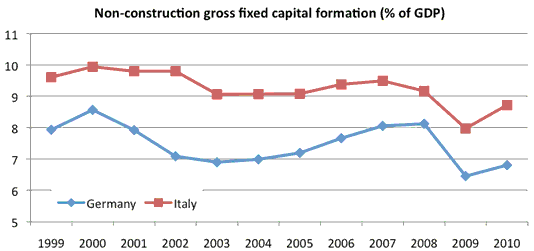
Source: AMECO dataset, European Commission (DG ECFIN).
Infrastructure investment by the government is often cited as another reason for low growth. But it has averaged around 2.5% of GDP over the last 20 years, which is in line with the EU average (and again higher than in Germany). More infrastructure investment is thus also unlikely to unlock higher growth.
The same observation applies to human capital. The Italian workforce is today actually better educated than 10 years ago. The percentage of those with a tertiary degree has increased from 13% to 18% of the working age population (and the percentage of those with only primary education has fallen).
While the share of tertiary education graduates in the active population is still lower than in partner countries, it grew faster in the last decade, which should have been a pro-growth influence.
Figure 2 shows for Germany and Italy the evolution of the population with a tertiary degree setting the level of 1999 equal to 100. It is apparent that Italy has made much more progress than Germany. In terms of human capital Italy has thus considerably narrowed the difference with Germany.
Figure 2. Active population (25-64) holding a tertiary education degree
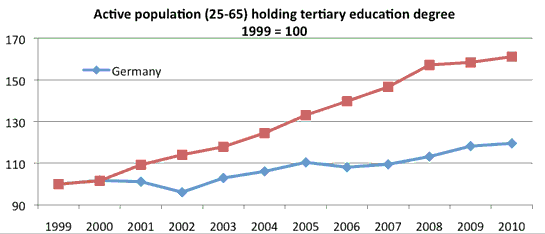
Source: Eurostat, Labour Force Survey.
Structural reforms?
Maybe the culprit is a lack of the medicine most commonly prescribed by economic doctors for Italy – ‘structural reforms’? Here again the evidence indicates a relative and absolute improvement. For example, the OECD indices on labour market and product market actually show a substantial improvement if one compares more recent values to the readings of about ten years ago. Moreover, Italy seems to have reached about the same level of (formal) employment protection and product market regulation as Germany.
Table 1. OECD structural reform indicators
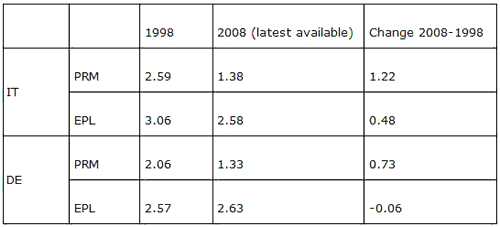
Source: OECD, PRM= Product market EPL = employment protection legislation.
Is it a lack of innovation?
Another growth-inhibiting factor often cited is the low level of investment in R&D in Italy. The level of R&D spending as a proportion of GDP is low in Italy, at 1.27% of GDP, corresponding to 62% of the Eurozone average. But in Italy R&D’s share in GDP has actually increased by about one fourth over the last decade, proportionally about the same as in Germany, and much more than in the rest of the Eurozone.
It is difficult to explain a slowdown of growth with low R&D spending when it has actually increased relative to most of Italy’s peers.
So what could thus explain the worsening of growth?
If all the obvious possibilities have been eliminated …
There is only one set of indicators on which the performance of Italy has clearly: the governance of the country. This can be measured by the Worldwide Governance Indicators (WGI) from the World Bank. The three most important indicators for the economy are:
- the rule of law;
- government effectiveness in general; and
- control of corruption.
Italy’s performance on all three indicators has deteriorated dramatically over the last decade.
Figure 3. Italy’s governance gap relative to the Eurozone core
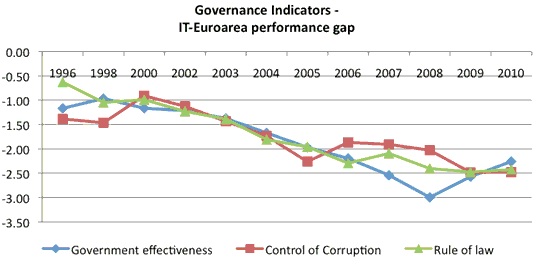
Source: WGI 2011, World Bank
Moreover, by all these measures Italy now ranks lower than any other Eurozone country (including Greece!). The difference between Italy and the Eurozone core is now over two standard deviations below the core Eurozone average.
Table 2. Governance indicators: performance gap Italy versus Core Eurozone
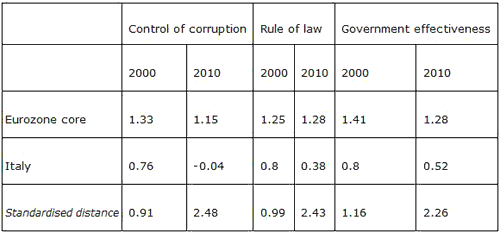
Source: WGI 2011, World Bank
Notes: “Control of corruption” captures perceptions of the extent to which public power is exercised for private gain, including both petty and grand forms of corruption, as well as “capture” of the state by elites and private interests. “Rule of law” captures perceptions of the extent to which agents have confidence in and abide by the rules of society, and in particular the quality of contract enforcement, property rights, the police, and the courts, as well as the likelihood of crime and violence. “Government effectiveness” captures perceptions of the quality of public services, the quality of the civil service and the degree of its independence from political pressures, the quality of policy formulation and implementation, and the credibility of the government’s commitment to such policies
Conclusions
Growth in modern industrialised economies is a complex process. Italy stands out among its peers as having experienced a ‘lost decade’ although most of the normal growth factors have improved.
Until 2008, the macroeconomic environment was also not challenging, at least not more so than for other Eurozone countries. The only area where there has been a clear deterioration is in the governance of the country.
The available indicators in this respect point to a significant deterioration over the last 10 years. This is one area where a reversal of the trend appears most difficult and it is also an area where external pressure cannot achieve much.
Unfortunately the importance of better governance has not yet fully grasped in the country (and the European institution) and receives little attention in the national political debate.
This implies that it will be difficult to organise a sustained effort to combat corruption, foster adherence to the rule of law, and improve the efficiency of the administration in general. However, progress on these fronts might in the end be more important for growth than the reforms now being imposed by the EU.
References
Eichengreen, Barry (2011), “The Big Cannoli”, Euro Intelligence, October 17.
![]()



Leave a Reply